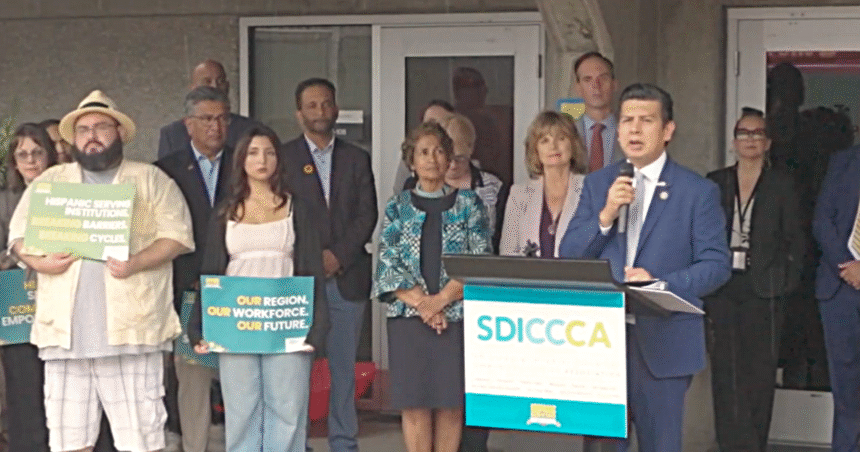CHULA VISTA — The San Diego & Imperial Counties Community College Association (SDICCCA), representing six community college districts and more than 200,000 students, joined state legislators, business leaders and students to call for the protection of Hispanic-Serving Institution (HSI) funding in the wake of the U.S. Department of Justice’s decision not to defend the program against a federal lawsuit Thursday, Aug. 28.
At a press conference hosted at Southwestern College, leaders stressed that HSIs are not preferential programs but essential workforce infrastructure that powers California’s economy.
“Community colleges educate 70% of California’s nurses and 80% of its first responders,” said Southwestern College President and SDICCCA President Mark Sanchez. “HSI funding strengthens the programs that prepare our essential workforce. Weakening this support undermines California’s safety, competitiveness, and prosperity.”
SDICCCA member colleges receive approximately $15 million, and if these funds were disrupted, critical student support services such as tutoring, advising, STEM labs, and first- and second-year experience programs would be at risk. These programs directly impact persistence, transfer and graduation. Without continued federal support, it would be extremely difficult to sustain them at their current scale.
Tens of thousands of students, especially first-generation and low-income, benefit directly. But every student on our campuses benefits from stronger advising, labs, and career pathways that these grants support.
California Assemblymember David Alvarez highlighted the bipartisan urgency of defending HSI programs. “Defending Hispanic-Serving Institutions is defending opportunity, equity and the future of California’s workforce,” Alvarez said.
Business leaders echoed the message, emphasizing the link between HSI programs and workforce readiness. Taylor Dunn, Director of Talent Initiatives, San Diego Regional Economic Development Corporation (SDREDC) explained:
“San Diego’s innovation economy is world-class, but growth is increasingly constrained by talent. While Hispanic/Latine students make up a large share of our K-12 pipeline, they are underrepresented in today’s innovation workforce, and too many graduates are not yet college-ready — leaving real jobs unfilled and real opportunity on the table. Hispanic-Serving Institutions are indispensable to closing that gap. HSIs enroll a significant share of Latine undergraduates and many Pell-eligible students; they anchor opportunity locally. Equally important, HSI funds support all students — strengthening advising, transfer, tutoring, work-based learning and completion across the entire community.”
Cuyamaca College alumnus and current San Diego State University student Manuel Juarez Lopez underscored the impact of HSI support. “I first started attending Cuyamaca College in 2022 because of the great value and opportunity the college provided, and to continue a passion of mine, competing with the Cuyamaca Men’s Track & Field team. What I soon discovered was a ‘true community.’ I can say firsthand that the strength of Hispanic-Serving Institutions of higher education creates meaningful pathways for students like me and others to succeed,” Lopez said.
Speakers from the press conference included:
-
David Alvarez, California State Assemblymember (AD-80)
-
Mark Sanchez, superintendent/president of Southwestern College and 2025-26 president of SDICCCA
-
Don Dumas, board president of Southwestern College and 2025-26 president of the SDICCCA Board Alliance
-
Lynn Neault, chancellor of Grossmont-Cuyamaca Community College District and 2025-26 vice president of SDICCCA
-
Geysil Arroyo, president of the San Diego Community College District Board of Trustees
-
Taylor Dunn, director of talent initiatives, San Diego Regional EDC
-
Manuel Juarez Lopez, student, Grossmont-Cuyamaca Community College District
About SDICCCA
The San Diego & Imperial Counties Community College Association (SDICCCA) represents six community college districts: Southwestern, San Diego, Grossmont-Cuyamaca, Palomar, MiraCosta and Imperial Valley. Together, these colleges serve more than 206,000 students and provide the workforce backbone of the region’s $250 billion economy.











